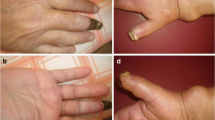n
= 20), including ligation of the fistula (n= 8), distal revascularization–interval ligation (DRIL) (n= 4), bypass (n= 4), sympathectomy (n= 1), ligation of the radial artery (n= 1), medical therapy (n= 1), and banding technique (n= 1). Medical therapy and banding relieved symptoms after thrombosis of the AVF. Through the use of DRIL, healing of finger necrosis (n= 3) and improvement of symptoms (n= 1) were achieved. The findings of this study indicate that severe hand ischemia occurs mainly in diabetic patients with multiple previous AVF and finger arteriopathy. DRIL is the conservative treatment of choice, since it can be used to achieve both symptomatic relief and maintenance of dialysis access.
Similar content being viewed by others
Author information
Authors and Affiliations
About this article
Cite this article
Sessa, C., Pecher, M., Maurizi-Balzan, J. et al. Critical Hand Ischemia after Angioaccess Surgery: Diagnosis and Treatment. Annals of Vascular Surgery 14, 583–593 (2000). https://doi.org/10.1007/s100169910107
Published:
Issue Date:
DOI: https://doi.org/10.1007/s100169910107




